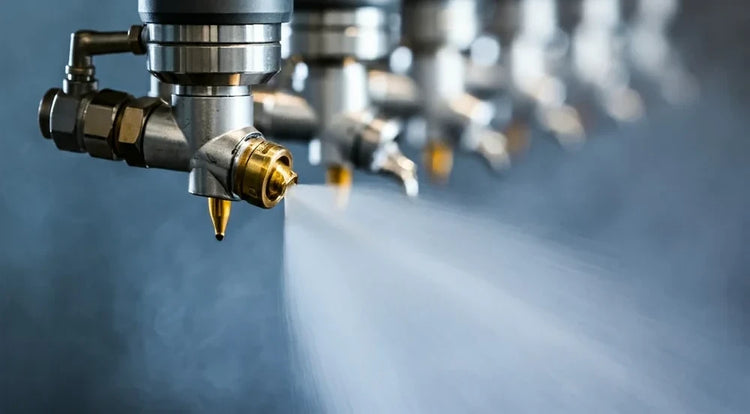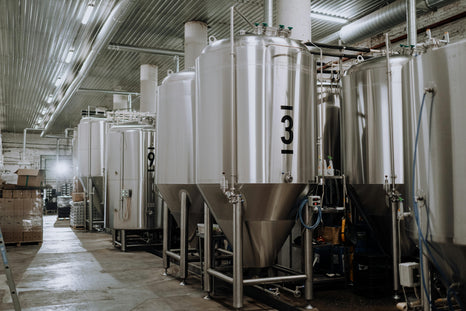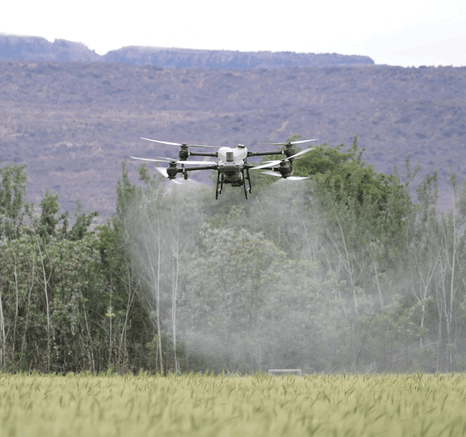Keeping your spray nozzles working well isn't always easy, but it's super important if you want them to last and do their job right. Over time, dirt, minerals, and other gunk can build up and mess with the way your nozzles spray. If you want to make sure your equipment keeps running smoothly, it's worth learning a few simple ways to clean and wash spray nozzles. This guide breaks down the top methods so you can keep things in good shape without too much hassle.
Key Takeaways
- Soaking nozzles in cleaning solutions helps remove tough buildup without causing damage.
- Ultrasonic cleaning baths are great for small or hard-to-reach nozzle parts.
- Using compressed air can clear out blockages safely, but avoid using sharp tools.
- Manual cleaning brushes are gentle and effective for most nozzle tips.
- Regular inspection and timely replacement of nozzles keeps spray patterns and flow rates consistent.
Soaking in Cleaning Solutions
Soaking spray nozzles in cleaning solutions is a common method that can help break down stubborn deposits and clogs inside the nozzle. This type of cleaning is especially useful when dealing with mineral buildup, chemical residues, or dried-on materials that regular rinsing just can't remove. The process is simple but requires the right approach to avoid damaging the nozzle.
Here are some straightforward steps for soaking spray nozzles effectively:
- Remove the nozzle from the sprayer or system.
- Select a cleaning solution that’s compatible with the nozzle’s material—always check the manufacturer’s guidelines first to avoid corrosion or weakening.
- Place the nozzles in a container filled with the solution.
- Allow the nozzle to soak. Soaking times usually range from 15 minutes to several hours, depending on the level of buildup.
- Rinse the nozzle thoroughly with clean water after soaking to remove any leftover solution.
- Inspect for any remaining clog; repeat if necessary.
Here's a quick table of common cleaning solutions and appropriate nozzle materials:
|
Cleaning Solution |
Safe For |
Typical Buildup |
|
Diluted Vinegar |
Stainless, some plastics |
Mineral deposits |
|
Mild Detergent |
Most metals, plastics |
General dirt, grease |
|
Diluted Acid Cleaner |
High-grade alloys (check guidelines) |
Heavy mineral scale |
Taking your time during the soaking process can really make a difference—don't rush it and be careful about what solution you use for each nozzle type. Overly strong chemicals or the wrong solution can actually do more harm than good.
Regular soaking fits nicely into a preventative maintenance routine and helps extend the lifespan of industrial spray nozzles.
Ultrasonic Cleaning Bath
Ultrasonic cleaning baths have become a go-to method for cleaning spray nozzles, especially when dealing with extremely fine or sensitive orifices. These baths use high-frequency sound waves in a liquid medium to break up and remove stubborn deposits from both the inside and outside of nozzle components.
Here’s how the process typically works:
- Place the nozzle into the ultrasonic bath, completely submerging it in the cleaning solution (usually water or a compatible solvent).
- Activate the ultrasonic machine. The bath emits sound waves that generate microscopic cavitation bubbles.
- These bubbles implode, dislodging dirt, mineral scale, and other residues, even from crevices that brushes can’t reach.
- After several minutes, remove the nozzle, rinse thoroughly, and let it dry fully before reinstalling.
Key advantages of ultrasonic cleaning:
- Gentle on nozzles—minimizes risk of scratching or deforming openings
- Consistently removes buildup, even in hard-to-reach areas
- Reduces the need for harsh chemicals or abrasive scrubbing
|
Consideration |
Ultrasonic Bath |
Manual Cleaning |
|
Cleaning Time |
5–20 minutes |
Varies, longer |
|
Reach |
Internal/external |
Mostly surface |
|
Suitability |
Small/or intricate |
Large/accessible |
If you’re maintaining a fleet of precision spray nozzles, running them through an ultrasonic cleaning bath can keep performance optimal without introducing unnecessary wear or risk of damage.
Compressed Air Cleaning
Using compressed air to clean industrial spray nozzles is one of the best ways to clear out debris without damaging the nozzle itself. Compressed air can remove fine particles that are stuck in tight orifices or internal channels where brushes and liquid cleansers can't reach. For industrial environments where downtime matters, compressed air offers a quick and non-invasive maintenance step that can keep systems running smoothly.
Here’s how to get the most from compressed air cleaning:
- Remove the nozzle from the spray setup if possible, to avoid blowing debris further into piping.
- Direct a short burst of compressed air through the nozzle in the opposite direction of normal flow. This can help push out trapped material more effectively.
- Check for any leftover blockages—sometimes stubborn clogs may need a second round.
If you rely on compressed air as your main cleaning method, remember to use moderate pressure to avoid damaging delicate internals—excessive force can deform or widen the orifice, affecting spray quality and system precision.
Compressed air is especially good for maintenance routines in industries where nozzle openings are small and prone to gunk buildup from process fluids or minerals. Regular use helps reduce clogs, helping to avoid expensive unplanned stops for cleaning or repairs.
Manual Cleaning Brushes
Manual cleaning brushes are some of the most practical tools for keeping factory floor cleaning nozzles and heavy-duty cleaning nozzles clear of debris and buildup. With hands-on cleaning, you can remove mineral deposits, rust, or organic matter that typically gets stuck inside the nozzle's tiny internal passages. The right brush lets you reach into all those little nooks where automated solutions sometimes can't.
Here's a quick look at how to get the most out of brush cleaning:
- Choose the right brush: Select a brush with bristles that are stiff enough to dislodge blockages, but still soft enough to avoid scratching the nozzle surface. Nylon and brass are common choices depending on your nozzle's material.
- Use a gentle circular motion: Work the brush inside the nozzle without forcing it. This helps prevent damaging the orifice, which can lead to spray pattern distortion.
- Rinse thoroughly: After brushing, flush the nozzle with clean water to remove any loosened debris.
- Inspect your progress: Check the nozzle opening to see if any obstructions or residue remain—repeat if necessary.
For best results, combine manual brushing with routine nozzle inspections so you can catch blockages before they cause uneven sprays or equipment downtime.
A well-chosen manual cleaning brush can extend the working life of your nozzles and reduce unplanned maintenance. If your operation uses factory floor cleaning nozzles or heavy-duty cleaning nozzles, it's worth keeping a variety of brush sizes handy for different nozzle types. Remember to always refer to your nozzle manufacturer's care recommendations to avoid accidental damage during cleaning.
Line Strainers and Filters
In industrial spray systems, line strainers and filters are an often overlooked but key part of nozzle maintenance. These components help protect spray nozzles by catching dirt, sediment, or debris before it ever reaches the tiny nozzle openings. If you think about how frequently clogging issues pop up in process lines, especially when the water or chemical supply isn't pure, you see why filters aren't just an add-on—they're practically mandatory in many setups.
A line strainer is usually installed upstream of the nozzle, where it stops solid particles from continuing through the system. The mesh size of the strainer should match the nozzle's tolerance for particulates—too coarse, and it won't block enough material; too fine, and you risk frequent blockages that can impact flow rate.
Here are a few ways to keep your spray nozzles working like new with line strainers and filters:
- Use line strainers with a suitable mesh size for your application's particulates.
- Inspect and clean strainers regularly as part of your standard maintenance routine.
- Replace filters showing signs of wear or damage to prevent backflow or bypass of debris.
Here's a simple table showing typical mesh sizes matched with nozzle orifice sizes:
|
Nozzle Orifice (mm) |
Recommended Mesh Size |
|
0.5 – 1.0 |
100 – 200 |
|
1.1 – 2.0 |
60 – 100 |
|
2.1 – 3.0 |
30 – 60 |
Consistent filter maintenance can help you avoid unplanned downtime. It’s often the smallest contaminant that leads to the biggest repairs.
For a broad selection of industrial spray nozzles and related accessories, including filters and strainers designed for demanding settings, browsing the industrial spray nozzle solutions from specialized suppliers is a smart move.
Visual Nozzle Inspection
Visual nozzle inspection should be a regular part of any spray system maintenance routine. This method allows operators to catch early signs of wear, damage, or clogging that could seriously impact spray performance. Small cracks, corrosion, and mineral deposits can all be identified with a careful look. Even tiny changes in the orifice can cause big shifts in your spray quality over time.
Here’s a simple approach to visually inspecting spray nozzles:
- Remove the nozzle from its housing so all surfaces are visible.
- Use good lighting and, if possible, a magnifying glass to check for residue, build-up, or physical damage.
- Compare the nozzle to a new one of the same type to spot differences in the orifice shape or size.
- Look for signs of corrosion or material wear, especially around the orifice and threads.
- Check for uneven wear that could change spray direction or distribution.
Industrial spray nozzles are often made to tight tolerances, so even minor nicks or scratches can lead to unpredictable results. Never use sharp objects to clear a blockage—this could permanently damage the orifice.
Routine visual checks can help prevent unexpected downtime by spotting worn or blocked nozzles early, before they lead to larger process issues.
Spray Pattern Inspection
Spray pattern inspection isn't just a box to check—it's a real game-changer for industrial spray nozzle maintenance. Irregular or inconsistent spray patterns often signal issues like clogs, abrasion, or nozzle wear that can seriously reduce performance and efficiency. This is especially true for CIP spray nozzles (clean-in-place), which need to maintain strict coverage for proper cleaning.
Here's why routine spray pattern checks matter:
- Early Detection: Spotting problems before they cause downtime or impact production.
- Consistency: Making sure the right spray angle and distribution are maintained.
- Quality Control: Verifying that every surface or part gets even coverage.
A comparison table can help quickly document your inspection findings:
|
Inspection Criteria |
Normal Pattern |
Problem Signs |
|
Spray Angle |
As specified |
Reduced or shifted angle |
|
Distribution |
Even, uniform |
Streaks, gaps, hot spots |
|
Edge Definition |
Clear, consistent |
Blurred, irregular edges |
Take note: even a small change—like a narrowed spray angle—can mean it's time to clean or replace a nozzle. Don’t just glance and move on; spend a minute to watch how the spray lands and spreads.
If the spray pattern starts looking off center or patchy, address it right away to avoid bigger maintenance headaches down the line.
Flow Rate Monitoring
Monitoring flow rate is a key way to spot when industrial spray nozzles need cleaning or maintenance. A spray nozzle’s performance directly ties to its flow rate—when the amount of liquid passing through changes, something’s usually wrong. For instance, a gradual increase in flow could mean the nozzle orifice has worn down, letting more fluid through. On the other hand, sudden drops in flow often signal clogging from debris or mineral buildup.
Here’s how to use flow rate as a warning sign:
- Compare measured flow rates to original specifications or baseline values.
- Track any changes over time; even subtle shifts can signal wear or deposits.
- Check system pressure along with flow—problems often show up as both lower flow and pressure.
|
Situation |
Possible Cause |
Action |
|
Flow rate too high |
Orifice wear/erosion |
Inspect for damage |
|
Flow rate too low |
Clogging or buildup |
Clean or replace |
|
Unstable flow |
Partial blockage |
Perform thorough cleaning |
Regularly checking flow rate helps catch nozzle problems early, preventing wasted fluid, inconsistent spray patterns, and costly downtime. Simple meters or test kits can make this job quick and reliable.
Remember, keeping an eye on flow rate is about avoiding bigger issues before they start—no fancy tools needed, just steady attention and routine checks.
Routine Nozzle Replacement
Sticking to a routine nozzle replacement schedule makes a huge difference for industrial cleaning nozzles and system efficiency. Even the best cleaning and washing spray nozzles show signs of wear and tear after extended use. This wear can lead to inconsistent spray patterns, uneven coverage, or unnecessary water and chemical usage—all of which can slow down production or increase operational costs.
Here are some signs it’s time to replace spray nozzles for washing:
- The flow rate seems higher or lower than when new—often a sign of nozzle erosion or clogging.
- Spray patterns appear streaky, uneven, or distorted during surface cleaning or tank cleaning.
- Output from high-pressure cleaning nozzles lacks the force or coverage required for proper sanitation or parts washing.
A proactive approach is key. Instead of waiting for a problem or breakdown, mark nozzle replacement on your maintenance calendar based on usage hours or production cycles. Keeping spare equipment cleaning nozzles, industrial wash spray nozzles, and specific fleet & vehicle washing nozzles on hand helps avoid delays if issues crop up.
Common Replacement Intervals for Industrial Spray Nozzles:
|
Application |
Typical Replacement Interval |
|
Food & beverage cleaning nozzles |
Every 6-12 months |
|
Tank cleaning nozzles |
Every 9-18 months |
|
Pressure washing spray nozzles |
After 300-500 hours of use |
|
Industrial washdown nozzles |
Every 12 months |
|
Rinsing spray nozzles |
Annually, or by system demand |
Staying ahead of nozzle wear protects your equipment, maintains quality, and supports safe, dependable production—plus, it takes the stress out of last-minute repairs.
By paying attention to nozzle life cycles, performance metrics, and visible condition, plants can keep industrial washing spray nozzles in top shape, improving every cleaning task from sanitation to routine parts washing.
Material Compatibility Assessment
Making sure your spray nozzle material matches up with what it’s spraying—and with the environment it’s operating in—is just smart maintenance. If you overlook this, you’re likely to run into problems like corrosion, early wear, or even total failure, and nobody wants that. A mismatched nozzle material can quietly eat away at your efficiency and your budget.
Here’s what you should keep in mind when checking for material compatibility:
- Look at the chemicals or fluids passing through your nozzle. Some substances are much harder on metals and plastics than others.
- Consider heat. High temperatures can weaken certain materials, making them brittle or causing slow but steady damage over time.
- Don’t forget about abrasive particles. Sand, minerals, or even aggressive cleaning agents can erode nozzle surfaces if the material isn’t up to the task.
A quick reference table for common nozzle materials and their strengths:
|
Material |
Best For |
Not Recommended For |
|
Stainless Steel |
General process spraying, mild chemicals |
Strong acids, some chlorides |
|
Brass |
Water, low-pressure washing |
Acids, ammonia solutions |
|
Cobalt Alloy 6 |
Abrasive environments, extended wear |
High-cost, specialty only |
|
PTFE / PVDF |
Corrosive and acidic media |
Very high temperatures |
Taking the time to verify if your nozzles are made from the right material for your specific job can save you the hassle and cost of frequent replacements and breakdowns.
Check your records and run a quick review periodically, especially if you’ve changed processes or chemicals recently. Overlooking this step has tripped up even the most experienced plant managers. Keep it simple, stay vigilant, and your spray nozzles will go the distance.
Wrapping Up: Keeping Your Spray Nozzles in Top Shape
So, that's the rundown on cleaning and washing spray nozzles. It might seem like a small thing, but taking care of your nozzles really does make a difference. Regular cleaning, using the right tools (no sharp stuff!), and checking for wear or clogs can save you a lot of headaches down the line. Remember to pick cleaning methods that match your nozzle material, and don't forget to inspect the spray pattern every now and then. If you spot any damage or things just aren't working like they used to, it's probably time to swap out the nozzle. A little bit of routine care goes a long way—your equipment will last longer, and you'll get better results every time you spray.












